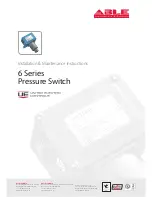
6
DXE-FVC-1 - Feedpoint Voltage Coupler
The
FVC-1
provides an interface for standard control switches, such as the
DXE-CC-8A
or your own arrangement to voltage-
multiplexed antenna systems. This interface system will provide the voltages required to remotely select up to four antennas (or four
directions) through receiving or low power transmitting feedlines. It provides fuse-protected 0V, +12 Vdc, -12 Vdc, and 12 Vac.
output voltages through a panel mounted feedline connector. These voltages can be used to provide four-direction switching of an
antenna array either through the feedline or on a single wire supplemental control line. Control is done using a standard 1 of 4, BCD
or switch closure interface. The
FVC-1
is recommended for use with the DX Engineering
RFS-2P
Remote Four-Square Antenna
System , the
RBS-1
Reversible Beverage Antenna System, and the
RLS-2
Transfer Switch.. The
CC-8A
Control Console can
provide the 1 of 4 and BCD input used by the
FVC-1
or you can use your own switch.
The
FVC-1
also has two LED indicators, red and green, which indicate the presence and polarity of the output control voltage being
used. They are directional indicators that can be read at a convenient distance and can aid in troubleshooting. Features
Safe, external 12V heavy duty power pack.
Metal Housing – superior shielding, rugged, and easy mounting
Convenient installation– mounts anywhere in your shack
Rugged Control Connector – reliable solder-less connections
Internal thermal reset fuse- full protection against accidental shorts
Flexible logic input- BCD or standard one-of-four, high or low actuated
Operation indicators- bright red and green LED indicators can be seen at a distance
DXE-RBS-1P - Reversible Beverage Antenna System - Two Direction
New, improved RF Shielded packaging!
The RBSA-1P allows two Beverage antennas receiving in opposing directions to share the
same space. With the RBSA-1P, build a 2-wire reversible Beverage antenna system with superior directivity and signal-to-noise ratio,
most useful on the 160, 80 and 40m bands. The W8JI design consists of a Feedpoint Unit and a Reflection Transformer. Use two
RBSA-1P's with a DX Engineering RLS-2 switch and have four-direction switching using a single feedline. This system is immune
to strong signal overload and core saturation common in multi-transmitter contesting environments, and is used
by winning contest stations and low-band DXers. As an recommended accessory, the DXE-RPA-1 preamp
utilizes a push-pull amplifier design and robust components enable it to withstand high signal levels. The
dynamic range of the RPA-1 is better than most receivers.
It can actually provide a high level of protection
against high RF levels and ESD for many transceivers with unswitched, unprotected receive antennna
inputs!
The RBSA-1P has two antenna ports. The standard configuration of the RBSA-1P has one port
terminated (termination included) so both antennas share a common feedline. Applying negative 10 to 18 Vdc to
the feedline switches between the antennas, and the direction of reception. For simultaneous reception from opposing directions, each
of the two feedlines can be run to separate receivers. While the RBSA-1P is optimized to use 450 Ω ladder line for the antenna
element, the system will work with any 300-600 Ω two-wire line. 450 Ω ladder line as well as high quality "flooded" 75 Ω coax and
F type connectors , to ensure a weather-tight installation, are available from DX Engineering and are sold separately.
Broad operating range, 0.2 to 30 MHz - Fully isolated grounds prevent common-mode noise and unwanted signals - 75 Ω design
enables the use of high quality, low cost cable and connectors - RF Shielded housing used for isolation and improved life
DXE-RFCC-1 - Receive Feedline Current Choke, 50 to 75 Ohm 300 kHz to 30 MHz
If you wish to reduce feedline radiation and improve reception, a Feedline Current Choke is recommended if your SWR is already
low. Adding a DX Engineering Feedline Current Choke at the point where the feedline exits the area of the antenna will substantially
reduce unwanted feedline radiation or reception without the need for improved station grounding.
The advantages of using an FCC
:
Prevents unwanted RFI by eliminating feedline current and radiation
All power goes to the antenna, improving efficiency
Reduces noise or unwanted signals picked-up by the feedline
Overcome a less than optimal ground system
The DX Engineering
RFCC-1
receive feedline common-mode choke is the most effective solution to common-mode noise or
unwanted signal ingress available to date. The DX Engineering
RFCC
provides thousands of ohms isolation between the input and
output coaxial shield connections while passing desired signals, including dc or low frequency ac control signals. The
RFCC
has
extremely high isolation impedance which effectively blocks common-mode noise or unwanted signals, even in the presence of very
poor grounding. Low noise receive antennas are traditionally located away from electrical wiring and other noise sources.
Unfortunately, noise and other unwanted signals have a direct path to your low-noise antenna through the feedline shield connections
between the station equipment and antenna. Unwanted signals can also energize the outside of the feedline shield, and this undesired
signal energy can be conducted directly to the receiving antenna. This can reduce antenna directivity. Unless you have a perfect zero-
resistance RF ground at the antenna, some of the common-mode noise or unwanted signals from the feedline shield will make it into
the antenna. The
RFCC
is effective from 300 kHz to 30 MHz. It comes with standard CATV type “F” female connectors, although it
can be used in any 50 to 75 ohm receiving system. The
RFCC
is a passive device, therefore requires no power to operate.


























